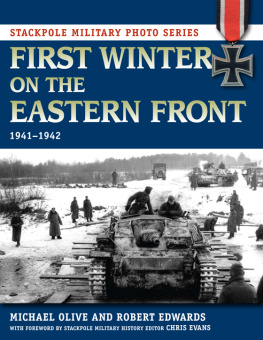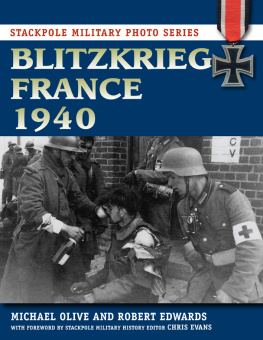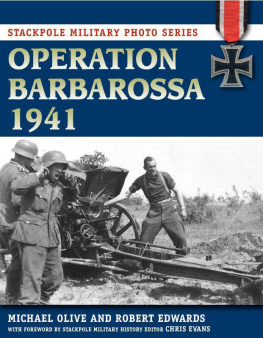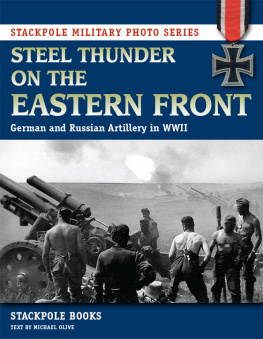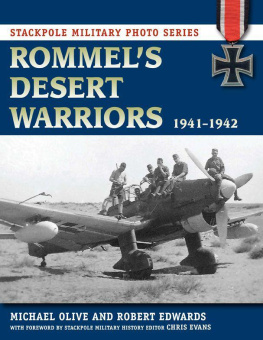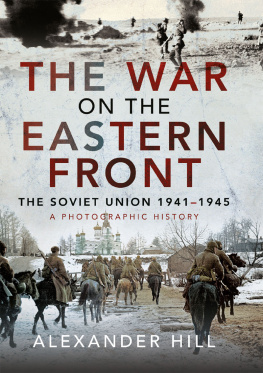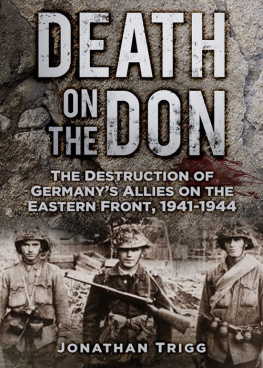Copyright 2013 by Stackpole Books
Published in 2013 by
STACKPOLE BOOKS
5067 Ritter Road
Mechanicsburg, PA 17055
www.stackpolebooks.com
All rights reserved, including the right to reproduce this book or portions thereof in any form or by any means, electronic or mechanical, including photocopying, recording, or by any information storage and retrieval system, without permission in writing from the publisher. All inquiries should be addressed to Stackpole Books.
Cover design by Caroline M. Stover
Printed in the United States of America
10 9 8 7 6 5 4 3 2 1
Library of Congress Cataloging-in-Publication Data
Olive, Michael.
First winter on the Eastern Front, 19411942 / Michael Olive and Robert Edwards ; with a foreword by Chris Evans.
pages cm. (Stackpole military photo series)
Includes bibliographical references.
ISBN 978-0-8117-1125-8
eISBN 978-0-8117-4975-6
1. World War, 19391945CampaignsEastern Front. 2. World War, 19391945CampaignsEastern FrontPictorial works. 3. World War, 19391945CampaignsSoviet Union. 4. World War, 19391945CampaignsSoviet UnionPictorial works. 5. Soviet UnionHistoryGerman occupation, 19411944. 6. Soviet UnionHistoryGerman occupation, 19411944Pictorial works. I. Edwards, Robert. II. Title.
D764.O44 2013
940.54'217dc23
2013011946
FOREWORD

I n May 1942, German Fhrer Adolf Hitler authorized the awarding of the Eastern Front Medal to all German combatants and foreign volunteers who served and fought in Russia between November 15, 1941, and April 15, 1942the first winter. The inherent irony in this is that the medal was never meant to exist. That it did meant Hitler, and Germany as a whole, had to accept a harsh new reality. Josef Stalins Bolshevik Russia had not, as Hitler predictedand promisedcome crashing to the ground when Germany launched Operation Barbarossa, the invasion of Russia, on June 22, 1941. If anything, the resilience of the Red Army presaged that many more winters of combat lay ahead.
Made of zinc and hung by a rayon ribbon of red, black, and white, the Eastern Front Medal is plain and far from rare: over 3,000,000 were awarded during the course of the war. Printed with the simple phrase Winterschlacht Im Osten 1941/1942 (Winter Battle in the East), the medal quickly received a nickname born from the gallows humor of those who survived the frigid horrors of that first winterGefrierfleischorden, the Frozen Meat Medal.
The German soldiers who fought in Russia in that first winter little expected the hardships they were to endure. The decisive land battles of 1939 and 1940, while not without cost, had gone so well and so quickly that they had every reason to believe in their Fhrers supreme confidence as they prepared to follow in Napoleons footsteps and march to Moscow. Blitzkrieg, both in myth and reality, had lived up to and even surpassed its reputation. Bolshevik Russia would surely succumb as had the others, from Poland to France. The immense size and tenacity of the Red Army, the vast distances to be covered, and especially the weather would quickly put that confidence to the test.
After rapid and startling success in the opening months of Operation Barbarossa that saw the Wehrmacht gallop ever eastward, the invasion faltered. Russian resistance increased, coupled with a stream of reinforcements not anticipated by the Wehrmacht. German forcesmany now more than 1,000 kilometers from their starting pointsand their supplies were exhausted, and badly in need of rest, repairs, and reinforcements. Grinding the advance down even further was the beginning of the autumn rains, which turned the dirt roads into valleys of mud.
And then the ground froze, and it began to snow. With the spires of the Kremlin in Moscow visible in the distance, by December 5 the Wehrmacht had nonetheless managed to march to within ten kilometers of the Russian capital. With the chance to lop off the head of the Bolshevik beast in the Germans sight, Stalin launched his counteroffensive, halting further advancement by the Germans. Reluctantly accepting that his forces could go no farther and fearing a repeat of Napoleons disastrous retreat from Moscow, Hitler issued a directive to go on the defensive. Lacking enough food, ammunition, supplies, and winter clothing, the Wehrmacht would now have to stand and fight both a rejuvenated Red Army and a bitter winter in order to survive until the spring.
Michael Olive and Robert Edwards join forces once more to give the reader a detailed view of the harrowing ordeal of that first, brutal winter on the Eastern Front. Using hundreds of photographs, many never before published, they illustrate the brutal conditions and the men and weapons that fought in them.
Chris Evans
Editor
Stackpole Books
INTRODUCTION
T he invasion of the Soviet Union by German forces on 22 June 1941 appeared to be an unprecedented success. The attack completely surprised the Soviets, and the front of 3,200 kilometers was ripped wide open. The Soviet forces on the border were badly deployed defensively and, except in a few instances, quickly overrun. The Germans advanced rapidly, forming massive pockets of trapped Soviet forces at Bialystock, Minsk, and Smolensk, taking literally millions of prisoners.
Initially, it seemed as if the campaign would be concluded swiftly, but the resilience of the Soviets and the effect of the vast distances on the transport of reinforcements and essential suppliesas well as the wear and tear on vehicleswere critically underestimated. The Soviet transport system was extremely primitive, with few paved roads, only one major highway from Minsk to Moscow, and a relatively sparse rail network that was of a different gauge than that of the German railways and had to be converted.
Although the Germans had won significant victories, they were still suffering casualties at an increasing rate, and replacements did not equal losses. Against the advice of his panzer group commanders, who pressed for an immediate assault on Moscow in July, Hitler diverted Guderians Panzergruppe 2 to assist Rundstedts Army Group South in securing the Ukraine and the Crimea. Not only was Moscow a politically prestigious target, but it was a vital transport and communications hub. Another huge pocket was created at Kiev and Marshal Budennys Southwest Group all but totally destroyedbut still the Soviet forces stubbornly fought on. The drive on Moscow was inexplicably, and ultimately fatally, delayed for nearly two months as the German High Command appeared to be unable to make a firm decision about their next objective.
Finally, on 6 September 1941, Fhrer Directive 35 was issued regarding the continuation of the war on the Eastern Front. The main objective was the elimination of the so-called Timoshenko Army Group operating on the Central Front. This army group was to be destroyed before the onset of winter conditions as a prerequisite for the advance on Moscow
In order to accomplish this task, all the available forces of the Wehrmacht and Luftwaffe that could be spared from the flanks were to be concentrated in the Army Group Center sector. The operation was given the cover name Taifun (Typhoon), and the attack was to begin at the earliest possible moment and was therefore planned for the end of September.

